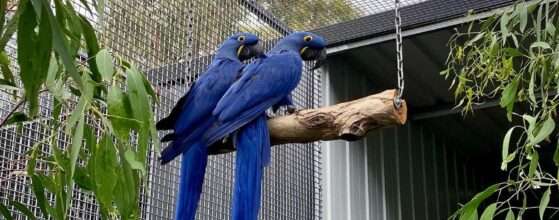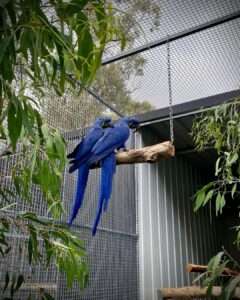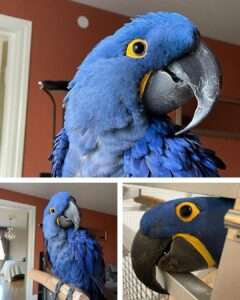
- by FPABS-Admin
- 0
- Posted on
Blue Macaw

 one of the most thrilling members of the parrot family worldwide for me is the Hyacinthine Macaw. If I was already much impresse by the behaviour and appearance of other macaws then this blue macaw exceeds its relatives in many respects. It is in my opinion one of the most intelligent parrots, if not the most intelligent and should like to pass on my observations and experiences of the Hyacinthine Macaw below.
one of the most thrilling members of the parrot family worldwide for me is the Hyacinthine Macaw. If I was already much impresse by the behaviour and appearance of other macaws then this blue macaw exceeds its relatives in many respects. It is in my opinion one of the most intelligent parrots, if not the most intelligent and should like to pass on my observations and experiences of the Hyacinthine Macaw below.
Keeping and breeding the Hyacinthine Macaw
In autumn 1987 I acquire a male Hyacinthine Macaw from a breeder which has been together with another male. It seem healthy but the plumage was not in very good condition. Some of the feathers were not the normal luminous blue, but were black. Occasionally black feathers are cited as a determinant for the age of the bird, in other words black means it’s a young macaw, but this cannot be correct. It is surely a sign there is something wrong with the structure of the feathers. The normal colouring is not recognisable and the feathers appear to be black. I have often notice a similar condition with Amazons after quarantine. The cramped conditions affects the plumage so badly that it is damaged and some feathers appear to be black.. After the first moult, however, these feathers regain their usual colouration. And so it was with my Hyacinthine Macaw.
Accommodation
In Spring 1988 the Hyacinthine Macaws were put in a larger enclosure with an inside area of 2 x 3 metres (6 x 9 ft) and an outside area of 3 x 6 metres (9 x 18 ft). In the inside area there were two nestboxes measuring 80 x 50 x 50 cm (30 x 20 x 20 ins) made of 4 cm (1.5 ins) thick beechwood planks. Whilst one was positioned horizontally just under the roof, the other was placed again horizontally, but 1.20 m (4 feet) from the ground. The horizontal position is I believe advantageous because the nesting material is usually in the back part. If the macaws are disturbed when breeding, they come to the entrance hole and do not trample the eggs. Equally the eggs are not so easily damaged by the adults rushing into the nestbox.
Diet
Before describing their diet I should like to mention that in my opinion it is one of the decisive factors for successful breeding. It should be as varied as possible. Seed is mainly provide sprout during the breeding period. If young are being rear then I offer it as well. I also provide fruit (apple, pear, cherries, plums, banana, orange etc.), berries red and black elder, rowan and vegetables (cucumber, onion, carrot, courgette, sweet pepper either fresh or defrosted. Half ripe deep frozen maize is much enjoyed by macaws. I therefore feed half a cob each to my macaws once or twice a week. It is all mixed in a large feeding bowl and sprinkled with a soft food mix, calcium and mineral supplements. Then they receive some dog biscuit as well as nuts (brazil, walnuts, hazel and pine-nuts) and occasionally dried shrimp. In addition I feed them meat in the form of cooked chicken bones and chop bones with meat remains. This is enjoy almost as much as nuts.
The first breeding season
In the second half of the year the pair appeared to come into breeding condition. Occasionally the female was fed by the male. In September the Hyacinhtine macaws were copulating regularly, but still showed no great interest in the nestboxes. I therefore placed a hollowed out fir tree stump 1.2 m high with approx. 40 cm diameter (4 ft with 15 ins diameter) in the outside area, but this was ignor as well. From October the copulating cease and was not observe any more throughout the entire winter.
